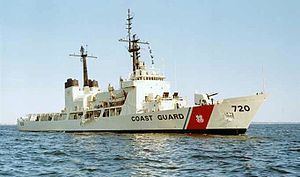Namesake John Sherman Commissioned September 3, 1968 Decommissioned May 1986 Launched 23 September 1967 Weight 3,302 tons Draft 4.6 m | Laid down January 25, 1967 Recommissioned July 1989 Construction started 25 January 1967 Length 115 m Displacement 2.948 million kg Builder Avondale Shipyard | |
 | ||
Name USCGC Sherman (WHEC-720) | ||
USCGC Sherman (WHEC-720) is a U. S. Coast Guard high endurance cutter now based out of Honolulu, Hawaii.
Sherman was laid down January 25, 1967 at Avondale Shipyards near New Orleans, Louisiana and launched September 3, 1968. She was named for John Sherman, the 32nd United States Secretary of the Treasury and author of the Sherman Antitrust Act.
Sherman was involved in search and rescue efforts following the sinking of F/V Big Valley near Saint Paul Island, Alaska, on January 15, 2005.
On March 17, 2007 Sherman stopped the Panamanian motor vessel Gatun about 20 miles off a Panamanian island. Gatun was loaded with 20 tons of cocaine with an estimated retail street value of $600 million. The seizure was the largest drug bust in US history and the largest interdiction at sea.
History
CGC Sherman’s keel was laid on January 25, 1967 at Avondale Shipyards in New Orleans, Louisiana. She was launched on September 23 of the same year and was commissioned on September 3, 1968.
CGC Sherman was originally homeported in Boston, Massachusetts where her primary mission was ocean station patrol in the North Atlantic.
In 1970, Sherman was assigned to Coast Guard Squadron Three in Vietnam. Her tasking during the conflict was primarily in support of Operation Market Time, which involved sorting through hundreds of small vessels off the Vietnamese coast in search of enemy weapons smugglers. Sherman’s crew inspected some 900 vessels during her 10-month tour in Southeast Asia. The old 5” gun (now replaced by a 76mm mount) answered 152 calls for naval gunfire support, including a running fight on the night of 21 November 1970 which resulted in sinking the North Vietnamese armed freighter SL-3, which was carrying tons of enemy munitions.
In 1971, Sherman returned to Boston. With satellite technology reducing the need for ocean station patrols and amid concern of the rising American drug problem, the emphasis shifted to drug interdiction. In October 1976, Sherman seized the 275-foot Panamanian freighter Don Emilio and confiscated 82 tons of marijuana, the largest drug seizure in history at the time. Responding to a need for greater operational resources in the Pacific, Sherman was transferred to her next homeport in Alameda, California in May 1979. Sherman’s primary missions shifted to Alaskan Patrols (ALPAT) involving fisheries law enforcement (LE), drug interdiction, search and rescue (SAR), and military readiness in the Bering Sea and Gulf of Alaska. Sherman was decommissioned from May 1986 until July 1989 to complete a 3-year Fleet Renovation and Modernization (FRAM) project at Todd Shipyard in Seattle, Washington. The project upgraded Sherman’s weapons, communications, aviation and other operating systems and completely renovated crew living and berthing spaces. Sherman completed ready-for-sea trials in July 1990 and once again commenced operational missions in the Pacific.
In July 2001, Sherman became the first Coast Guard cutter to circumnavigate the world, after conducting U.N. sanctions enforcement duty in the Persian Gulf and goodwill projects in Madagascar, South Africa, and Cape Verde.
In May 2006, the cutter participated with a U.S. Navy task group during a 5-month deployment to Singapore, Thailand, Indonesia, Malaysia, Brunei and the Philippines. In March 2007, Sherman received world-wide attention when her boarding team discovered more than 17 metric tons of cocaine aboard the Panamanian freighter Gatun, a record seizure in the Eastern Pacific. Sherman was awarded the Golden Eagle award by the White House for combined interdiction successes during 2007.
In May 2011, Sherman was transferred to San Diego, California. Sherman has continued her operations by accomplishing three drug interdiction deployments in the Eastern Pacific, a winter Alaskan patrol in the Bering Sea to enforce U.S. fisheries regulations and to provide search-and-rescue support during the Alaskan red king crab harvest, and by earning the Pacific Area Operational Readiness Award.
In May 2015, Sherman was transferred to her current homeport in Honolulu, Hawaii.
